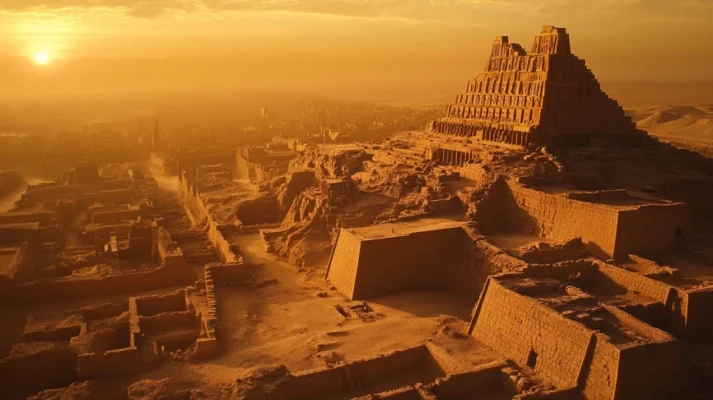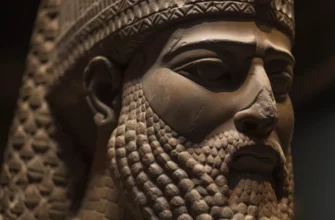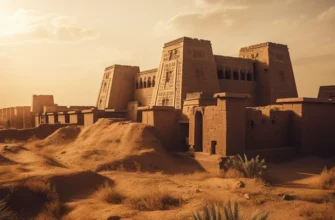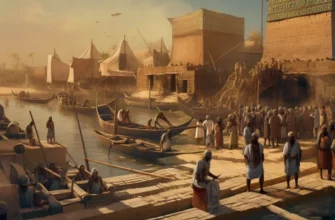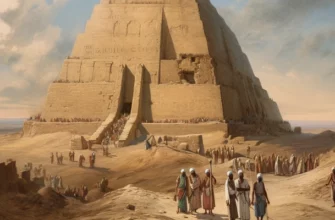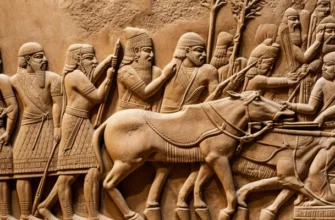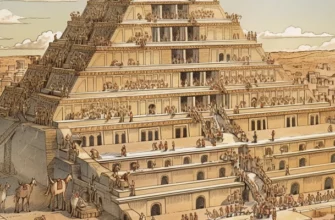Uruk is one of the oldest and most famous cities of Sumer, located south of modern Iraq. Founded about 5,000 years ago, it became an important center of culture, economy, and religion in ancient Mesopotamia. The city played a key role in the formation of Sumerian civilization and became one of the first major urban centers in the world.
Uruk reached its peak during the third millennium BC, when huge temple complexes, city walls, and other architectural wonders were built here. One of Uruk’s most significant achievements was the creation of one of the first forms of writing, cuneiform, which was used to record economic and religious records.
Uruk’s economy was based on agriculture, crafts, and trade. The city was an important center for the production of ceramics, textiles, and other goods that were exported to other parts of Mesopotamia. The social structure of the city was complex, with a clear division into upper classes, slaves, and artisans.
Uruk was also an important religious center. The city had numerous temples dedicated to gods, including the sky god An. Religious life and cult practices were an integral part of the daily life of its inhabitants.
Archaeological excavations in Uruk have uncovered many valuable finds, including parts of temples, statues of gods, and numerous cuneiform tablets. These studies have helped scientists better understand the culture and way of life of the Sumerians.
Uruk left a significant mark on the history of human civilization, and its importance as a cultural, economic, and religious center cannot be overstated.
History of the city of Uruk
Uruk was founded around 5000 BC south of modern Iraq, on the banks of the Euphrates River, and quickly became one of the most influential cities of ancient Sumer. Its location facilitated the development of agriculture and trade, which became the basis of its economic prosperity.
Foundation and early stages of development
The foundation of Uruk is associated with the beginning of the urbanization phase in Mesopotamia.
The city began to grow thanks to fertile lands that allowed for effective farming. Initially, Uruk was a small settlement, but over time, thanks to the development of technology, in particular irrigation systems, and a significant increase in population, the city became an important economic and political center.
The Golden Age of Uruk
The first half of the third millennium BC was the heyday of Uruk. The city became an important commercial and cultural center of Sumer, as well as one of the centers of Sumerian religion. It is known that at this time, a famous building was constructed in Uruk — the Temple of Eanna, dedicated to the sky god An. The city also became the place where one of the first writing systems, cuneiform, was developed and actively used for writing on clay tablets.
The rise and fall of the city
Uruk reached its peak in the middle of the third millennium BC, when it became one of the largest cities in the world at that time, with a population of up to 50,000. However, by the end of this period, the city began to decline, and by the middle of the 2nd millennium BC, its importance began to wane due to changes in the political situation, invasions by external enemies, and economic difficulties.
Over time, Uruk became a smaller and less important city, and its role in the history of Sumer diminished significantly. However, even after its fall, its influence remained in the cultural, religious, and scientific achievements that it passed on to other cities and civilizations of the time.
The history of Uruk is a testament to how cities of the ancient world could rise to greatness and fall, leaving behind cultural achievements that influenced future generations.
Culture and architecture of Uruk
Uruk was not only an important economic and political center of Sumer, but also a cultural capital where a unique civilization with a rich religious and artistic heritage developed. The architecture and culture of Uruk greatly influenced the development of other Sumerian cities and culture as a whole.
Uruk is known for its large-scale architectural structures, which became symbols of the city’s prosperity. The most famous architectural monument is the Temple of Eanna, dedicated to the sky god An. It was a huge temple complex that was an important part of the city’s religious life. The Temple of Eanna was located on a large area and was one of the largest religious centers in Sumer. Its architecture was characterized by high walls, huge gates, and numerous rooms for religious ceremonies.
In addition to temples, huge city walls were also built in Uruk to protect against enemies. These walls were among the largest in the world at that time and included powerful towers and gates. The city walls helped to ensure the safety of the city’s inhabitants and control trade routes.
Uruk was a well-planned city with a developed infrastructure. Streets and neighborhoods were divided according to their functions, such as religious, commercial, and residential areas. Advanced water supply and sewage systems kept the city clean and provided its inhabitants with water.
Uruk played an important role in the cultural life of Sumer, becoming a center for the development of writing. It was in this city that one of the first forms of writing was created — cuneiform, which was used to record economic and religious texts. Cuneiform was used to keep records of goods, as well as to record religious myths and laws. One of the important literary monuments associated with Uruk is the Epic of Gilgamesh, one of the first great epic works of humanity.
The ceremonial rituals and festivals held in Uruk were also an important part of the city’s cultural life. They were often accompanied by a great deal of music, dancing, and sacrifices to the gods, especially in the context of worship of the god An.
The art of Uruk was characterized by both religious and secular themes.
One of the greatest achievements was the production of stone and metal sculptures, including statues of gods and kings. Archaeologists have found numerous clay tablets with cuneiform writing, as well as relief images depicting everyday life, religious rituals, and military achievements.
Thus, the culture and architecture of Uruk were an integral part of its greatness. Huge temples, city walls, water supply systems, as well as cultural achievements in music, art, and writing defined the city as an important center of civilization in the ancient world.
Architectural achievements
The architecture of Uruk was one of the main factors that determined the greatness of this city. It reflected the technological progress and cultural significance of Uruk in the history of Sumer and the ancient world. Here are some of the main architectural achievements that distinguish this city.
The Temple of Eanna
One of the most famous architectural monuments of Uruk is the Temple of Eanna, dedicated to the sky god An. It was a large religious complex that became a symbol of the city. The temple was built of massive bricks and had huge interior spaces for worshiping the deities. Its architecture was not only impressive in size but also reflected the high level of engineering and construction achievements of the time.
City walls and gates
Uruk is also known for its large city walls, which were built to protect against external enemies. These walls were over 9 meters high and up to 6 meters thick at the bottom. They were built of fired bricks and had numerous watchtowers.
The wall was surrounded by huge gates that allowed passage only through controlled entrances, ensuring security and effective protection.
Irrigation systems
Since Uruk was located in a region with a hot climate, the city’s architects and engineers created a complex irrigation system that allowed the soil to remain fertile. Urban reservoirs and canals provided water not only for agricultural land but also for residential areas. These engineering achievements were an important aspect of the city’s development, as they allowed for stable crop yields even in dry years.
Palaces and administrative buildings
The large number of palaces and administrative buildings is also evidence of Uruk’s advanced architecture. The largest palaces were the residences of rulers and high officials. They were built mainly of fired bricks and often had numerous courtyards, gardens, and spacious reception halls. The architectural style was impressive due to its high ceilings and complex construction.
Monumental sculptures and reliefs
The architecture of Uruk also included numerous monumental sculptures and reliefs that adorned temples, palaces, and other buildings. These sculptures often depicted deities, kings, warriors, and scenes from religious life. They were not only decorative but also served a propaganda function, emphasizing the importance of religion and political power.
Sewerage and water supply
A developed water supply and sewerage system was also an important part of Uruk’s architecture. The water supply system provided the city with clean water, and the sewage system allowed for the efficient removal of waste. This helped maintain cleanliness and order in the city, which was essential for a large urban center.
The architectural achievements of Uruk testify to the high level of engineering and construction knowledge of the ancient Sumerians. Large temples, palaces, city walls, and a developed infrastructure allowed the city to flourish for many centuries, and its architectural heritage became part of the world history of civilizations. H3: The role of the city in the cultural life of Sumer
The economy of Uruk
The economy of Uruk was one of the main reasons for its prosperity and long-lasting importance in the history of ancient Sumer. Thanks to its favorable geographical location on the banks of the Euphrates River, the city became an important commercial, agricultural, and craft center of Mesopotamia. The economic system of Uruk was complex and multifaceted, covering various aspects from agriculture to the development of crafts and trade.
Agriculture
Agriculture was the main part of Uruk’s economy. Thanks to engineering and improved irrigation techniques, the Sumerians were able to significantly increase food production. A system of canals and reservoirs allowed the land to be irrigated, which contributed to the growth of grain crops such as barley and wheat, as well as vegetables and fruits. Barley was the main agricultural crop and was used not only as a food product but also as a raw material for beer production.
Agriculture was closely linked to animal husbandry. Domestic animals such as oxen, sheep, and goats played an important role in the economy. Animals were used to transport goods and as a source of meat, milk, and wool.
Trade
Trade was a key element of Uruk’s economy, thanks to which the city gained significant economic power. Uruk was an important trading center where goods were exchanged with other cities of Mesopotamia and neighboring civilizations.
Trade routes connected Uruk with other major cities of Sumer, as well as with territories outside Mesopotamia, including Egypt, the Indus Valley, and Arabia.
The main goods exported from Uruk were ceramics, textiles, metals, jewelry, and agricultural products. In exchange for these goods, Uruk received precious metals (including gold and silver), stone for construction, spices, and other exotic goods.
Crafts
Uruk was an important center of crafts, including the manufacture of pottery, textiles, jewelry, and clay tablets for writing. Craftsmen created various household items, tools, and decorative items.
It is known that it was in Uruk that the technology for producing high-quality ceramics developed, ranging from simple tableware to complex decorative items.
Metallurgy and goldworking occupied a special place in the city’s economy, where innovative techniques were used to produce metal products, particularly bronze.
Writing and administration
The economy of Uruk was highly organized, and the first form of writing, cuneiform, was used to manage it. Initially, cuneiform was used to keep records of goods and trade transactions. Clay tablets were used to record the quantity of products shipped for sale, as well as information about taxes and obligations.
Religious and administrative bodies that controlled the distribution of resources and regulated trade relations were also important for the economic life of Uruk. This ensured the stability and efficiency of the city as an economic center.
Social structure and labor
The economy of Uruk was based on a complex social structure. A class hierarchy divided the population into rich and poor, artisans, farmers, and slaves. The upper classes, such as priests and rulers, had great power and controlled economic resources, including land and crafts. Artisans and farmers performed hard labor, while slaves worked in the fields and workshops.
Uruk’s economy was complex and multifaceted, with a strong emphasis on agriculture, crafts, and trade. It was based on the efficient use of natural resources and technological advances such as irrigation systems and the development of writing for keeping economic records. This allowed Uruk to flourish and become one of the largest and richest cities of the ancient world.
Religion and social structure
Religion and social structure were closely intertwined in Uruk, and belief in the gods and their power influenced all aspects of city life, including politics, economics, and culture.
Uruk was an important religious center, and its social structure reflected a complex hierarchy based on functions and roles in society. Religion in Uruk was polytheistic, and the city had numerous temples dedicated to various deities.
Religious beliefs shaped the lives of the city’s inhabitants, and the performance of religious rituals was an important part of everyday life.
The main gods of Uruk
One of the main deities of Uruk was Anu, the god of the sky, who was considered the patron of the city. Anu was an important symbol of divine power and was revered as the supreme god. Huge temples were dedicated to him, including the Temple of Eanna.
Other gods also played an important role in the religious life of Uruk. Among them were Ishtar, the goddess of love and war, and Enlil, the god of air and noise. In particular, the goddess Ishtar was very popular in Uruk and was a symbol of fertility and sexuality.
Religious practices
The religious practices of Uruk included numerous rituals, sacrifices, and festivals aimed at satisfying the desires of the gods and maintaining their favor. Celebrations were held in temples, in which the inhabitants of the city participated, offering sacrifices, dancing, and singing.
One of the main religious rituals was the sacrifice of livestock and other animals, which was considered a way to maintain balance between humans and the gods.
The social structure of Uruk was complex and clearly defined. It included several classes, each of which had its own role in society.
Rulers and aristocracy
At the top of the social pyramid were the rulers, who were representatives of divine power on earth. The kings of Uruk were considered intermediaries between the gods and humans, and their power was sacred. They ruled the city and were the chief military commanders and religious leaders. The aristocracy also included high-ranking officials and landowners.
Priests and religious ministers
Priests occupied an important place in the social structure. They performed religious rites in temples, looked after cults, and ensured the support of the deities through prayers and sacrifices.
Priests also had a great influence on political life, as they provided a link between the king and the gods. They ruled temples, which were not only religious centers but also economic ones, as they had large land holdings at their disposal.
Free people and craftsmen
The majority of the population of Uruk consisted of free people who were engaged in agriculture, crafts, trade, and other activities. Craftsmen who made pottery, jewelry, textiles, and worked with metals were in high demand and played an important role in the city’s economy.
Slaves and dependents
At the bottom of the social structure were slaves and dependents who worked on the land or in workshops, often performing hard physical labor. Slaves could be people captured during military campaigns or those who fell into slavery due to debt or other circumstances. They had no personal rights and worked for the upper classes.
Religion and the social structure of Uruk were closely intertwined, and religious beliefs determined not only everyday life but also the political and economic organization of the city. Religious rituals and worship of the gods were crucial to the well-being of the community, and the social structure was based on a hierarchy in which kings and priests occupied the highest positions, while craftsmen and peasants played an important role in providing for the city.
Archaeological excavations and modern research
Archaeological excavations and modern research in Uruk began in the early 20th century and have continued ever since. As one of the largest and most important cities in Sumerian history, Uruk has been the subject of intensive archaeological research, which has helped uncover many important finds that shed light on the lives of the ancient Sumerians, their culture, religion, and economy.
The beginning of archaeological excavations
The first serious archaeological research of Uruk was conducted in the early 1900s by German archaeologist Leopold von Schmidt.
From 1912, excavations continued under his leadership, and he made many important discoveries. One of the most significant finds was the discovery of the huge temple of Eanna, dedicated to the sky god An, as well as other religious buildings.
Later, excavations in Uruk were carried out by other archaeologists, including German and Iraqi expeditions, which led to the discovery of numerous important objects, such as clay tablets with cuneiform writing, sculptures, and other materials that provide insight into the life of this great city.
Major archaeological finds
Archaeological excavations in Uruk have uncovered several important objects and architectural monuments:
Temple of Eanna: This is one of the largest temple complexes in Uruk, dedicated to the god An. The temple was huge and had a complex architecture with lots of halls and shrines. It gives us important info about the religious practices of the Sumerians.
City walls: Excavations have uncovered parts of the mighty city walls of Uruk, which testify to the high level of architecture and defensive structures of the time.
Clay tablets: During the excavations, archaeologists found numerous clay tablets with cuneiform writing containing important information about the city’s economic activities, political life, and religious rituals.
Sculptures and reliefs: Archaeologists have uncovered numerous sculptures, statues, and reliefs depicting gods, kings, and scenes from everyday life. These works of art provide insight into the religious beliefs and social structure of the city.
Irrigation systems: Excavations have also helped uncover the remains of complex irrigation canals that were used to irrigate agricultural land. This highlights the importance of the agricultural sector in Uruk’s economy.
Modern research and technology
Modern archaeological research uses the latest technology to better study Uruk and its heritage. One such method is GIS (geographic information system), which helps identify unknown archaeological sites and better analyze the structure of the city. Using remote sensing and aerial photography, archaeologists can detect the remains of buildings and even urban structures that are not visible on the surface.
Another important area of modern research is the analysis of clay tablets with cuneiform writing. Studying this writing allows researchers to decipher the economic, religious, and social aspects of life in Uruk. The latest methods also help to study the various materials from which artifacts were made, such as metal, ceramics, and stone.
Archaeological museums and publications
Finds from Uruk are kept in numerous museums around the world, including the German Archaeological Institute in Berlin and museums in Baghdad. These artifacts provide insight into the ancient culture of Uruk and the Sumerians as a whole.
Publications and research by archaeologists contribute to a deeper understanding of the development of Sumerian civilization and its influence on subsequent cultural and social structures in Mesopotamia.
Contemporary challenges and preservation
Despite numerous archaeological achievements, Uruk and other ancient cities of Mesopotamia face serious problems due to military conflicts, climate change, and illegal archaeological activities.
Preserving the cultural heritage of Uruk is an important task for modern archaeologists and international organizations, as these artifacts not only reflect the history of the city but are also part of the world’s cultural heritage.
Archaeological excavations and modern research in Uruk have greatly expanded our knowledge of this great city of Sumer. They have revealed new aspects of Sumerian life, culture, religion, economy, and social structure. Thanks to the latest technologies, archaeologists continue to make new discoveries that allow us to better understand this important civilization in human history.
Conclusions
Uruk is one of the largest and most influential cities of ancient Sumer, and its importance in history is undeniable. The city became an important cultural and scientific center where one of the first forms of writing, cuneiform, was developed. This significantly changed the way information was stored and became the basis for the development of administrative, economic, and legal systems that influenced the evolution of civilizations in Mesopotamia and beyond. In addition, Uruk was an important center of arts and crafts, particularly in pottery, metallurgy, and jewelry. Huge architectural monuments, such as the Temple of Enki, and numerous works of art attest to the high level of Sumerian culture and architecture.
Uruk’s economy was multifaceted, thanks in part to advanced irrigation systems that allowed agriculture to flourish. Trade and exchange with other cities and regions ensured the city’s economic prosperity. Uruk was also an important political and religious center. Gods and religious practices had a huge influence on the life of the city. Temples played not only a religious but also an economic role, and rulers and priests wielded considerable political power, organizing administration and social structures.
The city of Uruk also had a significant influence on subsequent civilizations, particularly the development of Akkad, Babylon, and Assyria, which borrowed many elements of administrative and social organization, as well as writing. Archaeological excavations carried out in Uruk have uncovered many important finds that shed light on the culture, economy, and social structure of this ancient city. The study of these materials provides a better understanding of how Sumerian civilization developed and its influence on the further development of human history.
Overall, Uruk played an important role in the development of the ancient world, and its legacy became the foundation for many aspects of life in subsequent civilizations, both in Mesopotamia and in other parts of the world.
